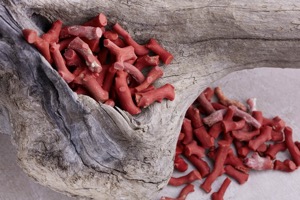 The origin of the name coral has many doubts.
The origin of the name coral has many doubts.
According to some, it derives from the Greek word “koraillon” which means “hard skeleton”, and according to others it derives from the Hebrew word “Goral”, a name used to describe the stones of the Hebrew oracle in Palestine, Asia Minor and the Mediterranean.
As for the origin of coral, Greek mythology attributes it’s birth to when Persius cuts off Medusa’s head, whose blood gushes out into the waters of the sea and dyes some of the marine plants red, turning them into stone; giving birth to the origin of coral.
Through the centuries, numerous naturalist scientists placed coral as number one among minerals and vegetables.
It was only until the XVII century that the Neapolitan alchemist and astrologer Filippo Finella asserted that coral was really an animal; a theory also adopted by Filippo Cavolini, a professor of the University of Naples, who published in 1683, “Memorie per servire alla storia dei polipi marini”, subsequently, in 1723 with a study carried out by the Frenchman Jean Antoine Peyssonnel, it was understood that what was mistaken for a flower was really a polyp whose tentacles were stretched out towards the cell.
These colonies of polyps (polipaio) form coral, unfortunately the scientific community ridiculed this theory and only after a study commissioned by the Académie Royale Des Sciences was it given its rightful merit.

It’s not exactly known how long this material has been used by man but ancient ruins shed some light on a very ancient civilization that dates back to 35,000 years ago where big pierced globes of coral were found and with all probability were used as amulets during this period.
Throughout the course of history, beyond its use as jewelry, coral has been used diversely: 5,000 years ago, in Asia, it was used as currency; and many ancient cultures used it as a Talisman to scare away bad spirits; and in the cave of Piccioni in the province of Chieti, amongst Neolithic burials, a small red coral deity statue was found, which historians say had an esoteric use.
Coral was numbered amongst the precious gems throughout many great civilizations.
It was greatly appreciated by the Sumerians, Egyptians, Fenicians, and even the Celtics who used it to adorn themselves.
During an archaeological dig in Syria the inventory of the so called “tesoro della Dea”, “treasure of the Goddess”, was recovered and in which dozens of coral pieces of jewelry from the Hellenistic age were found.
The Greeks and the Romans were also great admirers of coral objects and according to them the carvings made into the coral were considered works of art.
Today, like in ancient times, this material is valued for its positive effect as well.
In fact, it is said that coral eliminates fear and tension, encourages positive living, and contains reinvigorating and protective powers.
Due to this, it was given long ago to babies as a gift.
There are number of different uses for coral: in medicine, above all oriental medicine, in the cosmetic industry; and uses as well in the furnishing, clothing and collection fields.
In recent ages, the list of cities where coral was greatly diffused and worked on were: Marsiglia, Napoli, Trapani Genova, and Livorno.
It was towards the XIX century that the Marsiglian Paolo Bartolomeo Martin established the first great factory of coral.
Thanks to him, the working of coral diffused into the city of Torre del Greco, where fishing was the only previous practice.

